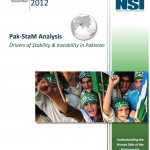Pak-StaM Stability Model Analysis of Pakistan

Pak-StaM Analysis Drivers of Stability & Instability in Pakistan.
Author | Editor: Astorino-Courtois, A. et al. (NSI, Inc).
This report addresses a number of key questions regarding the factors that underpin stability and instability in Pakistan. In particular: Which are the factors that most significantly contribute to governing, economic, and social stability in Pakistan? Are there factors commonly associated with stability that have no effect or have divergent effects on stability in Pakistan? What are the primary effect dependencies among factors? Is the effect of specific factors likely to change with time?
Pakistan sits at the center of South Asian regional security dynamics. Each of its several international borders has been both the cause of inter-state dispute and the site of militarized conflict. There are high levels of crime, violence, and sectarian conflict, and the writ of the state is challenged in many areas of the country. Porous borders facilitate organized crime, and militant activity further challenges state control and threatens the physical security and wellbeing of the Pakistani people. Investment (both government and private) in the weakly institutionalized, corrupt, and aid-dependent formal economy is insufficient to keep up with population growth, let alone enable Pakistan to reach its Millennium Development Goals. Finally, weak civilian governance, and a strongly politicized military blurs the lines of de jure authority.
Yet, despite these significant problems and frequent predictions of imminent failure of the Pakistani state, Pakistan persists. Struggles over division of authority between the judiciary and elected leaders have weakened but not toppled the civilian government, or triggered a military coup. While militants continue to challenge the writ of the state, they have not succeeded in fracturing Pakistan or establishing uncontested control. Discussion of the causes of Pakistan’s problems, and prescriptions for their cure are plentiful; however, there is less to be found on the factors that have enabled the Pakistani state and people to survive these challenges. Addressing the question of why Pakistan has not failed is equally important if we are to develop a complete picture of Pakistan’s current situation and future trajectory. This requires us to determine not only the factors that drive instability, but also those that buffer stability.
The following report addresses a number of key questions regarding the factors that underpin stability and instability in Pakistan. In particular:
- Which are the factors that most significantly contribute to governing, economic, and social stability in Pakistan?
- Are there factors commonly associated with stability that have no effect or have divergent effects on stability in Pakistan?
- What are the primary effect dependencies among factors?
- Is the effect of specific factors likely to change with time?
The analysis uses a conceptual model of state stability—the StaM—to systematically identify the drivers of instability as well as the areas of resilience in Pakistan. We find that while there are evident drivers of instability, there are also less immediately evident areas of resilience that buffer the stability of the state of Pakistan and its people. Moreover, the factors that appear to underpin Pakistan’s resilience to collapse are closely linked to those that may promote instability in the longer term. That is, it appears that, for Pakistan, shorter-term stabilizers can easily become destabilizers in the longer term. Conversely, there are factors that disrupt to the status quo, and can appear destabilizing, but are in fact an essential part of generating the structural changes Pakistan needs to achieve long-term stability. Accounting for both the short-term and long-term effects of various drivers of stability is essential for understanding their full implications for stability.
The remainder of this chapter provides a brief introduction to the StaM and our analysis of Pakistan. Development and analysis of the model specified to Pakistan–the Pak-StaM–illuminated several factors that appear to be pivotal to stability conditions in Pakistan. Each subsequent chapter explores the short and longer-term implications of a critical domestic factor identified as driving stability conditions in Pakistan including:
- the grey economy;
- formal foreign remittances;
- patronage;
- weak civilian institutions;
- education; and
- access to information.
The Stability Model (StaM)
A well-founded conceptual framework is an essential tool for any systematic analysis, especially when dealing with a concept as complex and interdependent as state stability. Whether acknowledged or not, all analyses are conducted in reference to some theory or implicit mental model. A conceptual model is simply a formal articulation of this same process. By specifying the factors that contribute to a phenomenon and the relationships between them, conceptual models help the analyst to check the logic, consistency, and comprehensiveness of the explanation and to understand not only what might occur but why, and what might be done to either encourage or impede it.
For the purposes of the analyses described in the following chapters, the overall durability (versus fracture) of a nation-state is defined as a compound function of its political, economic, and social stability. Each of these is performance-based where the political system is able to
- maintain a degree of legitimacy, political performance, and/or the coercive power necessary to retain internal control;
- sustain sufficient growth in the economic system (formal or informal) to support the minimal needs of the majority of citizens (i.e., the average growth rate in productivity exceeds the growth rate in population); and
- ensure that social cleavages do not result in violent ethnic or sectarian conflict.
The analysis of stability and instability drivers in Pakistan presented here employs the Stability Model (StaM) as an organizing framework for assessing political stability over the mid- to longer-term. According to the generic StaM,3 overall state stability arises from three necessary, but not sufficient, dimensions: economic stability, social stability, and governing stability. The definitions of these dimensions and their disaggregation are based on a wide range of academic and applied research and theory (including anthropology, international relations, comparative politics, social psychology, and economics).
Before using the StaM to assess stability dynamics in a specific context, further specification and tailoring of the model to that state or region is required. To begin the search for key drivers of stability and instability in Pakistan, analysts used the generic model as a set of assertions or hypotheses about political, economic, and social dynamics to guide their search for Pakistan-specific data. In an iterative process, researchers used the model’s organizing structure and the predicted relations within and across dimensions (governing, economic, and social stability) to gain insight into complex stability dynamics that characterize Pakistan. In all, over 1000 unclassified sources were used to tailor the generic StaM for Pakistan. These included: quantitative data on political processes, popular perceptions and opinion, and economic and financial flows; extensive area expert elicitation; current research on social, ethnic, economic and political and institutional cultures in Pakistan; social geography; and assessment of authority and political transitions through Pakistani history.
As information was gathered, three types of alterations were made to the generic model. This tailoring process, beginning with the generic model in Figure i-1, generated the specified Pakistan model shown in Figure i-2. The first step involved adjusting, adding, or eliminating factors shown in the generic StaM to align with the Pakistan context. For example, to account for its strong political influence, the Pakistani military was added to the generic model as a political actor with its own source of legitimacy in competition with civilian governors and interests. In the generic model, the role and performance of the military is incorporated under rule of law and national security. It was also necessary to distinguish explicitly between internally and externally generated revenue, as Pakistan is heavily dependent on foreign aid and loans to provide public services. The second type of alteration involved further disaggregating the generic factors to capture their state-specific nature (e.g., the components that constitute quality of life from the perspective of Pakistani culture, rather than U.S. culture). Finally, researchers considered whether the between-factors relationships anticipated by the generic model existed in the same way, or indeed at all, in the Pakistan context and confirmed or redrew these connections accordingly.
Once the model was tailored, and concepts defined for the Pakistan context, analysts set about the more complex task of assessing the extent to which each if these drove instability or provided a buffer to stability. This process led to the identification of the six major determinants of stability that form the structure of this report: the grey economy, formal foreign remittances, patronage, weak civilian institutions, education, and access to information. “Following the thread” of each of these factors through the model allowed us to build a picture of how these dominant factors affected stability within and across dimensions and over time. Using the model to follow stability implications in this way provides a number of benefits to the analyst and planner.
- Cross dimensional analysis accounts for the interactive complexity of state stability and provides better insight into the dynamics driving the complex macro system that is Pakistani state and society.
- By distinguishing between short and longer-term effects, the Pak-StaM can help analysts identify situations (e.g., patronage) that may buffer stability in the short-term, but ultimately block many of the structural changes required for longer-term stability.
- The ability to account for domestic stability effects of regional actors enables detailed mapping of the regional influences on Pakistan’s stability. Where specifically do the interests of regional actors affect stability in Pakistan? In addition, is it possible to map the effects of external actors’ interests on Pakistan’s domestic dynamics?6
- The StaM suggests a new perspective on how we think about stability and change in countries such as Pakistan. In particular, the United States Government (USG) needs to recognize that not all short-term instability is bad. In fact, short-term disruption is the likely result of the very structural changes–social, political and economic—Pakistan needs in order to achieve longer- term stability and development.
Caveats
The StaM is not a computational model; it presents a conceptual map intended to help trace and describe complex and multi-dimensional relationships. Even the generic StaM is highly complex and incorporates multiple theories from diverse disciplines. Although theory is sufficiently well developed and tested to create computational models of discrete sections of the StaM, compiling these into a single computational model of the entire StaM would require the imposition of a great number of assumptions regarding the relative weighting and interactions between the components. We currently lack the theoretical and empirical knowledge to model with any level of confidence. For similar reasons, there is no precisely delineated scale of time in the model.
Our “short term” and “long term” are better understood as “current” and “sometime in the future, all else being equal and given current patterns.” Neither the StaM nor the data available are sufficient to make definitive, point-predictive assessments of where things are going in Pakistan (e.g., as a time- series regression analysis on economic data or sales figures) other than to say, “if things stay the same, x is the most likely outcome” or “if y changes, z is the most likely outcome.” Nearly all of the effects in the Pak-StaM are interconnected and highly conditional. To predict what might happen on the basis of what we see now would require more assumptions, including the absence of any significant changes in factors in the period under study, than it is reasonable to make.
Contributing Authors
Belinda Bragg, Danette Brickman, Sarah Canna, George Popp, Alex Stephenson, Richard Williams (NSI)

Comments